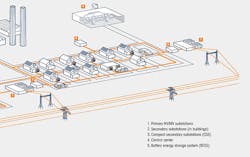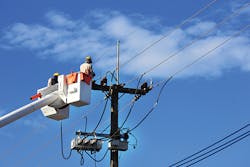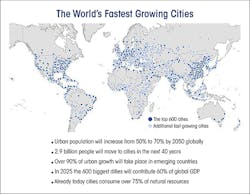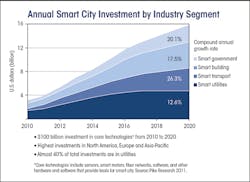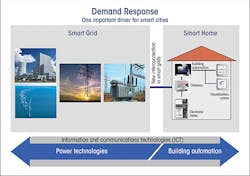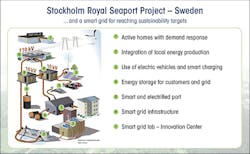A term currently being bandied about is attracting quite a bit of attention and causing some confusion: the “grid’s edge,” also referred to as the edge of the grid. This expression refers to the interface between the customer and the electric power supply. The confusion factor comes with the fact it also can be used to describe the hottest new technologies — for example, distributed energy resources (DER) and Internet of Things (IoT) — living at the end of the electrical distribution system.
This endpoint also is part of the discussion. Some experts consider the customer’s interface with the grid as the edge while others go beyond the meter. The notion of being on the edge stems from the opinion that the grid originates from centralized generation. From there, it runs through the transmission system and down to the customer’s connection. This is at the outer reaches of the grid through the distribution system — hence, the edge of the grid. Move any farther out, and it would be off the grid entirely.
It’s not really about which is smarter, the transmission grid or the distribution network. The bottom line is the distribution system is not prepared for the technology being thrust on it from this sector. There also is the issue of the disruptive nature DER systems — for example, microgrids, rooftop solar and fuel cells — have on the grid. The existing grid is designed for large remote generation plants, but DER is changing the game plan with a multitude of small distributed sources, making it a two-way system.
However, the real driving force from the edge is the customer’s total acceptance of IoT applications used on their tablets and smartphones. They have turned their businesses and homes into massive interactive systems with control and functionality. With all this activity, one thing is certain: The distribution system is changing and thus has given way to the fact the utility business models are changing and consumers are becoming power producers. Technology is redefining how electricity is produced, where it is produced and how it is delivered, including load adapting to production rather than generation following load.
Digital Transformation
Future energy demands require the grid’s edge to be interactive and automated. It has to be more efficient, reliable and capable of carrying high-quality power to the customer with better operational performance than ever before. That is a big order, but the new digital technologies are the key.
The changing electrical industry was the subject of the annual Edison Electric Institute conference held in Chicago, Illinois, in June 2016. When asked about the changing energy world, Chris Hickman, president and CEO of energy services company Innovari, said, “The edge of the grid will define us for the next 30 years.” Hickman described the edge as this: “A term for demand response, distributed generation, and other reforms or additions to the traditional grid.”
The convergence of DER and IoT technologies is driving the development and implementation of a new power-delivery system, and it is coming from the grid’s edge. It has the promise of delivering increased situational awareness needed for grid optimization and better health management of distribution equipment. This network will use the same basic infrastructure of today, but it will also draw on advanced monitoring, control and communications technology presently only beginning to be applied. Like the edge of the universe, the edge of the grid is expanding.
Customers have not only embraced IoT technology, they have jumped on to every new application and technical toy available to make their lives more efficient and environmentally friendly. If one doubts this, look at devices such as Tesla’s latest Powerwall unit introduced in 2015. Powerwall is a chargeable battery pack designed for the home to store solar energy from its rooftop solar system. It places the energy storage directly at the source of the renewable solar source that customers are installing in such great numbers.
Tesla sold about 38,000 of these battery packs in preorders alone. The production capacity for the first half of 2016 sold out before the year was even half over. Not only that, but Tesla has announced it is moving on to the next version. Customers are already lining up to buy the next generation while the first generation is still flying off the shelves. It seems Tesla has brought electric vehicles to a new level and answered the storage problem for solar power behind the meter at the same time.
Digital Awareness
There is one problem, however; the distribution system does not yet have the magnitude of digital awareness needed for this evolution. Think about it: If a transmission line trips, the utility’s operations center immediately knows everything about that disturbance. Not only does the operations center know what happened and where it happened, but steps are underway to reroute the power through other hubs and lines.
Remote switching takes place under the control of a vast array of computer-controlled systems. Even more astonishing is the fact so much of these energy management systems perform their magic nearly autonomously. Their intelligence has the ability to predict system behavior and make decisions to prevent and mitigate disturbances.
What happens on the distribution side of the coin? Well, the distribution system has not reached the transmission system’s level of digital sorcery, but it is evolving. To be fair, the distribution network is a different breed. Back in the day, distribution circuits were designed as a series of radial lines with a mix of branching laterals making up the individual feeders.
There were some loops within this system but not many, and what alternate pathways there were needed manual switching when called to operate. For the most part, very little monitoring took place downstream of the substation. The end user provided feedback through a telephone call to the utility’s trouble line to start the utility’s restoration process. A maintenance crew drove the feeder to track down the location and cause of the problem. It was a simple design for a simpler time, but times are changing with the activity now coming from the edge of the grid.
The Call to Modernize
Today’s demand for high-quality power needs a more autonomous network like the transmission grid. It is driven by IoT and DER technologies’ zero tolerance to any type of interruptions or voltage fluctuations. The power-quality sensitivity of these technologies does not fit well with the unadorned distribution scheme prevalent in today’s world. These old-school radial distribution systems need human intervention for any sort of adjustment. Fortunately, this has been changing since the early 1990s as more automation and interactivity have been applied to the grid’s edge.
Hundreds of pilot projects were developed and deployed worldwide, changing the distribution topography. The downstream side of the distribution substation clearly moved to center stage as all these influences came together, focusing attention on the need to move the distribution system into the 21st century.
For DER and IoT connectivity to inhabit the distribution system successfully, there has to be improved reliability with fewer or no outages, which is bucking distribution trending according to global experts. Worldwide, studies point out distribution networks are the weak link in system reliability.
A U.S. Department of Energy (DOE) report stated roughly 90% of all power outages in North America take place on the distribution system. Other reports agree this percentage pretty much reflects the rest of the world’s distribution infrastructure.
To put this in perspective, a DOE report estimates the cost of power-related outages in the U.S. is approximately $150 billion annually. A GE study estimates power outages cost businesses in the European Union about 150 billion euros annually. Globally, the World Bank survey estimates the average monetary loss as a result of power outages is about 4.7% of a country’s annual sales.
The Driver
These figures point out how expensive loss of power can be to a nation’s economy. The expectations placed on the distribution system have never been higher. This is the case whether talking about regulatory business, technical drivers or economic impacts. Imagine if the distribution system could react to disruptions as quickly as the transmission grid does, which is exactly what adding all these new DER and IoT operating features on the distribution grid is all about. Attaching these elements has added complexity.
What needs to be added to make the distribution grid smart? A great deal of discussion is taking place within the power industry and outside of it as to what exactly should be included in the idea of a smarter edge. Ask a roomful of industry experts to define the term and there will likely be a wide range of answers. Similarly, most customers — commercial and residential — would likely associate smart meters, or energy management, and automation of varying degrees with the smarter edge of the grid, but it really should be described in the broadest sense of the technology. It is a landscape that combines operational systems and business intelligence to create a more dynamic grid.
It also is the place where many things can happen at the same time. As the variables increase, it is much harder to forecast power flow and model how the system will react to disruptions. Adding DER and IoT means there are a lot more elements to keep track of than ever before. Fortunately, computing power is increasing, which makes it possible to model bigger and more complex distribution systems.
In addition, the electric utility industry has more of a variety of devices with a rich mixture of advanced communications infrastructure. This makes it possible to get different levels of connection to the field assets, enabling the possibility of choosing the quality of service needed to meet the requirements of the application.
Digital Topography
There are two schools of thought about where to install the digital distribution system’s intelligence. One group advocates a distribution grid should have all the intelligence on the edge. The other view is to put as much intelligence into it at the center (that is, in the distribution substation) as possible. Frankly, it appears the correct answer is to locate the intelligence from the substation up to and including the customer’s side of the meter.
Utilities need the ability to run a system that enables them to have as much oversight as possible — to do everything from central planning of the grid to outage response to workforce management. Yet, at the same time, all of the local elements in the grid need to take care of themselves as much as possible so they do not place much of a burden on the overall distribution system.
Originally, this technology was threatening to utilities, but the emerging distributed intelligence technologies are turning them into revenue possibilities, which are assets. Demand response includes industrial, commercial and residential resources managed by the grid. This distributed generation increases the renewable penetration, making them a virtual power plant on the distribution circuit where it is needed most. It also improves grid stability by optimizing demand and supply. In addition, moving the power source to the edge gets it closer to the energy consumer, which provides more capacity in the transmission grid.
Smart Cities on the Edge
All this technology is coming together in smart city efforts taking place worldwide. City governments and technology providers are working together to advance smart grid technologies used in real-world applications. It is estimated today’s urban population will increase from 50% to 70% by 2050 globally. It also is estimated today’s cities consume 75% of natural resources. The goal is to make the distribution network smarter and more responsive, and to improve the quality of life for those living in the cities.
A recent report from ABB broke down the annual smart city investment by industrial segment. The report found smart government accounted for 20.1%, smart buildings 17.5%, smart transportation 26.3% and smart utilities 12.6%, with the highest investments in North America, Europe and Asia-Pacific.
Helen Oy (formerly Helsingin Energia), an energy utility in Helsinki, Finland, is building a smart energy system in the Kalasatama district of Helsinki with ABB. It is a smart grid with remote metering and several types of automation, data and communications solutions combined with the traditional electricity, heating and cooling networks. The smart city application makes it possible to follow the energy consumption and level out consumption peaks by optimizing the consumption according to energy price level.
The system entails an infrastructure that supports local energy generation and electric vehicles, energy storage and efficiently functioning housing automation. With smart city technology, it is possible to generate, consume, store and sell electricity in a more flexible manner. At the same time, customers are getting more accurate information about their energy consumption.
Another interesting smart city development is Sweden’s Stockholm Royal Seaport urban development area project. This area is set to become the site of a unique research project with 150 new apartments being used in the pilot. Globally, leading companies have joined forces to equip these apartments with state-of-the-art energy technologies and connected appliances that enable residents to monitor and control their energy usage in real time.
The object of this collaborative effort is to develop and demonstrate smarter ways of managing energy and to help residents use energy more efficiently. The smart energy housing project in Stockholm is backed by a cross-industry consortium of key contributors Fortum, ABB, Ericsson, Electrolux and the Swedish Energy Agency.
Digital Future
The collaboration taking place at the edge of the grid is producing more than any one technology could provide, and the benefits of making it a reality extend far beyond the power system itself. The transition from the grid of today to the grid of tomorrow will be as profound as all the advances in power systems over the last 100 years, but it will take place in a fraction of the time. The big question is can traditional utilities and innovating companies meet on the edge and find a common ground to work together?
That said, this transition will not be easy. The integration of DER and IoT technologies of many different kinds will be essential to a functioning smarter distribution grid. This path to integration is only possible with interoperability standards. Realizing a smarter distribution grid’s potential will require a new level of cooperation between industry players, advocacy groups, the public and especially the regulatory bodies.
In the end, though, fully realized distributed intelligence from the grid’s edge will benefit all stakeholders.
About the Author
Gene Wolf
Technical Editor
Gene Wolf has been designing and building substations and other high technology facilities for over 32 years. He received his BSEE from Wichita State University. He received his MSEE from New Mexico State University. He is a registered professional engineer in the states of California and New Mexico. He started his career as a substation engineer for Kansas Gas and Electric, retired as the Principal Engineer of Stations for Public Service Company of New Mexico recently, and founded Lone Wolf Engineering, LLC an engineering consulting company.
Gene is widely recognized as a technical leader in the electric power industry. Gene is a fellow of the IEEE. He is the former Chairman of the IEEE PES T&D Committee. He has held the position of the Chairman of the HVDC & FACTS Subcommittee and membership in many T&D working groups. Gene is also active in renewable energy. He sponsored the formation of the “Integration of Renewable Energy into the Transmission & Distribution Grids” subcommittee and the “Intelligent Grid Transmission and Distribution” subcommittee within the Transmission and Distribution committee.



